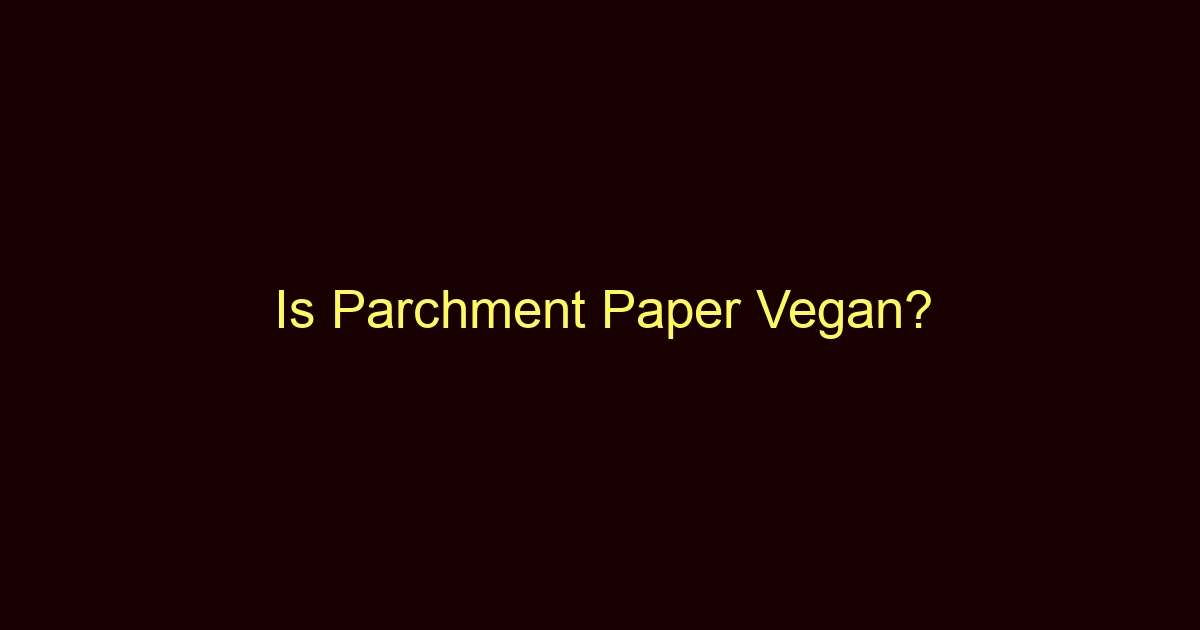While shopping for your kitchen essentials or when planning to bake your favorite treats, you might come across parchment paper. You may wonder if parchment paper is vegan-friendly or if it’s a product you should be concerned about. Let’s embark on a journey to understand more about this kitchen staple.
What is Parchment Paper?
Parchment paper, also known as baking paper or bakery release paper, is a cellulose-based paper that has been treated or coated to make it non-stick. It’s a favorite tool among bakers and cooks alike due to its various uses in the kitchen. It is highly heat-resistant and prevents food from sticking, making it ideal for baking, roasting, and even steaming.
The origin of parchment paper dates back to ancient Egypt, where it was used for writing before the invention of paper. Its name comes from the ancient city of Pergamon, where it was first produced. However, modern-day parchment paper is vastly different from its ancient counterpart. But what exactly is parchment paper made of?
What is Parchment Paper Made of?
Parchment paper is made from paper pulp, which undergoes a treatment process to enhance its heat resistance and non-stick properties. It is usually soaked in an acid bath, which dissolves the cellulose fibers to gelatinize them. Then, it is passed through a bath of sulfuric acid, which partially dissolves the paper to make it grease- and moisture-resistant.
Afterward, the paper is washed and buffered to neutralize the pH, and finally, dried and coated with a non-stick material, typically silicone. Despite its complex production process, no animal products are used. However, let’s further delve into what parchment paper is used for and where you can find it.
What is Parchment Paper Used For?
Parchment paper is most commonly used in baking. It’s used to line baking sheets, cake tins, and roasting pans to prevent food from sticking and make cleanup easier. It’s also used to create a sling in a baking dish to easily lift out baked goods. You can use it to create piping bags for icing, to wrap and cook en papillote, or even to separate items before freezing.
Where Can You Find Parchment Paper?
You can find parchment paper in most grocery stores, often in the baking aisle. It’s also widely available online. Parchment paper is generally sold in rolls, similar to aluminum foil or plastic wrap, but you can also find it in pre-cut sheets or rounds for convenience.
Is Parchment Paper Vegan?
Yes, parchment paper is vegan. As we’ve mentioned before, parchment paper is made from paper pulp and goes through a chemical process to make it non-stick and heat resistant. The non-stick coating is typically silicone, a synthetic polymer made from silica (sand). No animal products or byproducts are used in the production of parchment paper, making it suitable for a vegan lifestyle.
Can Vegans Use Parchment Paper and Why?
Vegans can definitely use parchment paper. Since no animal products are used in its production, it aligns with the principles of veganism. Plus, parchment paper is a handy tool for vegan baking and cooking. It can help with baking vegan goods evenly, preventing them from sticking to the pan, and makes cleanup a breeze.
Advantages and Disadvantages of Parchment Paper
Parchment paper has many advantages in the kitchen. It’s heat resistant up to very high temperatures, it’s non-stick, and it helps to evenly distribute heat, which can result in more consistent baking outcomes. Its non-stick properties mean you can use less oil or fat in your cooking, which can make your meals healthier.
However, like anything else, parchment paper is not without its downsides. Its single-use nature can contribute to waste, although some brands are compostable or recyclable. In addition, it can sometimes be more expensive than alternatives like aluminum foil or silicone baking mats.
Alternatives to Parchment Paper
If you’re looking for alternatives to parchment paper, there are several options. Silicone baking mats are reusable and have excellent non-stick properties, making them a more eco-friendly choice. Aluminum foil can be used, but it does not have the same non-stick properties as parchment paper. Greasing or oiling the baking tray can also work for certain recipes, but it may result in a different texture or browning level.
Some bakers also use a dusting of flour or cocoa powder (depending on the recipe) to prevent sticking. However, each of these options can produce slightly different results, and the best choice often depends on what you are cooking or baking.
Environmental Impact of Parchment Paper
While parchment paper is vegan-friendly and has numerous culinary benefits, it’s important to acknowledge its environmental impact. Parchment paper is often single-use, contributing to waste. The production process also involves the use of chemicals, which can have environmental implications.
However, some brands offer unbleached parchment paper, which is a slightly more eco-friendly option. There are also compostable or recyclable parchment papers on the market. Ultimately, reusables like silicone baking mats can be a more sustainable choice if you’re looking to minimize your environmental footprint.
Final Thoughts
Parchment paper is vegan. It is made from paper pulp and does not involve the use of any animal products or byproducts in its production. It is a useful tool for vegan cooking and baking, providing non-stick surfaces and aiding in even cooking.
However, like with many products, it’s crucial to balance convenience with environmental considerations. Using reusable options where possible, choosing unbleached, recyclable, or compostable parchment paper, and recycling when appropriate can help minimize your impact on the environment.

